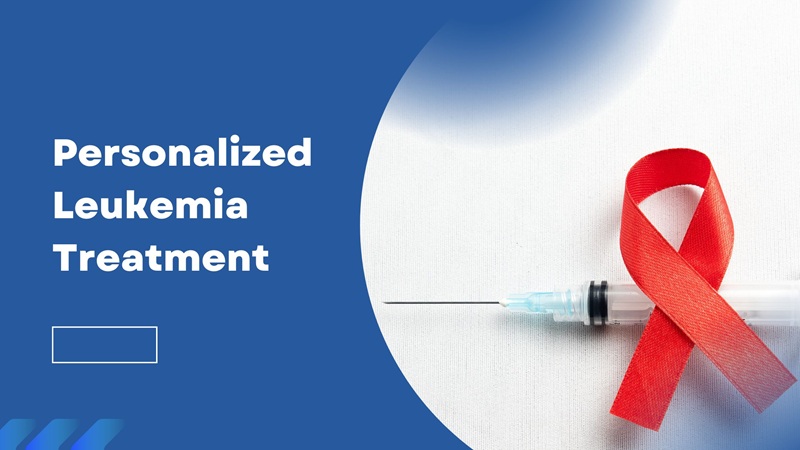The Importance Of Individualized Care
Personalized treatment is now the standard. It’s about tailoring care to you. No more one-size-fits-all approaches.
It’s about understanding your specific needs. Doctors consider your health history. They also look at the specifics of your leukemia.
This approach aims for better outcomes. It also focuses on your overall well-being.
How Genetic Factors Influence Treatment
Genetics play a big role in leukemia. Your genes can affect how the disease develops. Understanding these factors is key.
Genetic testing helps doctors choose the right treatment. It can also predict how you’ll respond to therapy. This is a core part of personalized medicine.
This knowledge allows for more targeted approaches. It also minimizes unnecessary side effects.
The Role Of Patient Preferences
Your preferences matter in personalized treatment. It’s not just about what the doctor thinks is best. It’s about what works for you.
Treatment goals should align with your values. This includes considering your lifestyle and priorities. It’s about balancing efficacy with quality of life.
Open communication with your care team is essential. This ensures your voice is heard throughout the process.
Advancements In Targeted Therapies
Overview Of Targeted Treatments
Targeted treatments are changing the game. Targeted therapy focuses on specific parts of cancer cells. It’s like hitting the bullseye instead of the whole dartboard.
These therapies often involve drugs that block the growth signals or blood vessel formation needed by cancer cells. This approach minimizes damage to healthy cells.
Think of it as precision medicine. It’s about finding the right treatment for the right patient at the right time.
Examples Of Successful Targeted Therapies
Imatinib (Gleevec) is a success story. It targets the BCR-ABL protein in chronic myeloid leukemia (CML). This protein is a result of a genetic mutation in CML cells.
Another approach involves the use of monoclonal antibodies, which are designed to recognize and bind to specific antigens on leukemia cells, helping the immune system identify and destroy them.
These therapies have significantly improved survival rates. They offer hope where traditional chemotherapy might fall short.
Benefits Of Targeted Approaches
Targeted approaches offer several advantages. They often have fewer side effects than traditional chemotherapy. This is because they’re designed to attack cancer cells, not healthy ones.
Targeted therapy can be more effective in certain cases. It’s especially true when the cancer has a specific genetic mutation that can be targeted.
Personalized medicine is the future. It’s about tailoring treatment to the individual, not just the disease. This approach can lead to better outcomes and improved quality of life.
The Impact Of Immunotherapy
Mechanisms Of Action
Immunotherapy is changing how we fight leukemia. It’s all about using your own body’s defenses to target and kill cancer cells. Think of it as training your immune system to recognize the enemy.
It works by boosting the activity of immune cells, like T-cells, so they can find and destroy leukemia cells. This approach is different from traditional treatments like chemotherapy, which can harm healthy cells too.
Immunotherapy aims to be more precise, minimizing side effects while maximizing the attack on cancer.
Types Of Immunotherapy For Leukemia
There are several types of immunotherapy being used to treat leukemia. One popular method is CAR-T cell therapy. This involves taking T-cells from a patient, modifying them in a lab to recognize leukemia cells, and then infusing them back into the patient.
Another type involves monoclonal antibodies. These antibodies are designed to target specific proteins on leukemia cells, marking them for destruction by the immune system. These therapies are often used when other treatments haven’t worked.
Checkpoint inhibitors are also used. These drugs block proteins that prevent T-cells from attacking cancer cells, essentially releasing the brakes on the immune system.
Success Stories In Immunotherapy
Immunotherapy has shown remarkable success in treating certain types of leukemia. Patients with relapsed or refractory acute lymphoblastic leukemia (ALL) have seen significant improvements with CAR-T cell therapy. It’s giving hope where other treatments have proven ineffective.
For example, some clinical trials have shown high remission rates in patients treated with CAR-T cells. This means the cancer is no longer detectable after treatment. The long-term effects are still being studied, but the initial results are promising.
Immunotherapy is not a cure-all, but it represents a major step forward in leukemia treatment. The future looks bright for immunotherapy and its potential to improve outcomes for more patients.
Monitoring Treatment Effectiveness
The Role Of Genetic Profiling
Genetic profiling is super important. It helps us see how well the leukemia treatment is working. It’s like having a map to track the cancer’s response.
It’s not just about seeing if the cancer is gone. It’s about understanding how the cancer cells are changing over time. This helps doctors make better decisions about your care.
Genetic profiling can also help predict if the cancer might come back. This way, doctors can be proactive and adjust the treatment plan if needed.
Understanding Minimal Residual Disease (MRD)
MRD is a big deal. It stands for Minimal Residual Disease, and it’s all about finding those sneaky cancer cells that are still hanging around after treatment. Finding MRD is key to knowing if the treatment really worked.
Think of it like this: even if you feel better, there might still be a few cancer cells hiding. MRD testing helps us find them. It’s like a super-sensitive detective for cancer.
MRD testing can be done in a few ways, like with blood tests or bone marrow biopsies. The results help doctors decide if you need more treatment.
Adjusting Treatment Based On Monitoring Results
Monitoring isn’t just about getting data. It’s about using that data to make smart choices about your leukemia treatment. If the monitoring shows the treatment isn’t working, it’s time to change things up.
Maybe the dose needs to be adjusted, or maybe a different drug is needed. The goal is to find the best way to fight the cancer. It’s all about being flexible and responsive.
Monitoring helps us personalize the treatment even more. It’s like fine-tuning a machine to get the best performance. The more we know, the better we can do.
Quality Of Life Considerations
Balancing Efficacy And Side Effects
Treatment decisions aren’t just about killing cancer cells. It’s also about how those treatments impact your day-to-day life. Finding the right balance is key.
We need to consider the side effects of each treatment option. Some side effects are manageable, others can be really tough. It’s a trade-off, and it’s personal.
The goal is to choose a treatment that’s effective but also allows you to live as fully as possible. It’s a conversation with your doctor, weighing the pros and cons.
Patient-Centric Treatment Goals
What matters most to you during treatment? That’s what we should focus on. It’s not just about survival rates.
Maybe it’s being able to keep working, or spending time with family. Perhaps it’s maintaining your hobbies. These are all valid goals.
Treatment plans should be built around your individual needs and priorities. It’s about making sure you have a say in your care.
Support Systems For Patients
Going through leukemia treatment is hard. You don’t have to do it alone. Support is out there.
Family and friends can be a huge help. But sometimes you need more specialized support. There are support groups, therapists, and other resources available.
Don’t hesitate to reach out. Having a strong support system can make a big difference in your quality of life during treatment.
Challenges In Personalized Treatment Plans

Personalized leukemia treatment offers great promise, but it’s not without its hurdles. Getting the right treatment to the right patient at the right time can be tricky. Let’s look at some of the main challenges.
Limitations Of Genetic Testing
Genetic testing is key to personalized treatment, but it’s not perfect. Tests might not catch every relevant mutation. Plus, we don’t always know how to interpret the results we get.
Sometimes, the tests don’t give a clear answer. This can leave doctors unsure of the best treatment path. It’s like having a map with missing sections – you can’t always see the whole route.
Genetic testing is constantly improving, but it’s not a crystal ball. We need to be aware of its limits.
Access To Personalized Therapies
Not everyone can easily get personalized treatments. These therapies are often only available at big cancer centers. This creates a real problem for people who live far away from these centers.
Insurance coverage can also be a barrier. Some insurers might not pay for the latest personalized treatments. This means that even if a treatment exists, some patients can’t afford it.
Access to care should be equal for everyone, but that’s not always the case. We need to work on making sure everyone has a fair shot at the best possible treatment.
Cost Considerations
Personalized leukemia treatment can be expensive. Genetic testing, targeted drugs, and specialized care all add up. This cost can be a big burden for patients and their families.
Health systems also struggle with the cost. They have to balance the benefits of personalized treatment with the need to manage budgets. It’s a tough balancing act.
Finding ways to lower the cost of personalized treatment is important. This will help make it more accessible to everyone who needs it.
Future Directions In Leukemia Treatment

Emerging Research And Innovations
New research is constantly changing how we fight leukemia. Scientists are exploring new drugs and therapies. The goal? To make treatments more effective and less harmful.
- Gene editing technologies like CRISPR offer potential for correcting genetic mutations.
- New drug combinations are being tested to overcome resistance.
- Research into the leukemia microenvironment is revealing new targets.
Personalized medicine is the future, and leukemia treatment is at the forefront.
Potential For Broader Applications
What we learn treating leukemia can help with other cancers. The techniques and drugs developed for leukemia can be adapted. This could lead to better treatments for many different diseases.
- Targeted therapies developed for leukemia are being tested in other cancers.
- Immunotherapy approaches are being refined for broader application.
- Understanding leukemia genetics informs research into other blood disorders.
The Promise Of Precision Medicine
Precision medicine means tailoring treatment to each person’s unique disease. This approach uses genetic information and other factors. The goal is to choose the best treatment for each patient.
Personalized leukemia treatment is the future. It means better outcomes and fewer side effects. It’s about giving each patient the best chance at a healthy life.
- Advanced diagnostics are key to precision medicine.
- Data analysis helps predict treatment response.
- Patient preferences are integrated into treatment decisions.
In Summary
In conclusion, personalized leukemia treatment plans are a game changer for patients. By focusing on the unique aspects of each person’s leukemia, doctors can create strategies that are much more effective. This means not just targeting the cancer itself, but also considering how treatments affect a patient’s daily life and overall health. With ongoing research and advancements in technology, these tailored approaches are likely to continue improving outcomes for many patients. If you or someone you know is facing leukemia, exploring personalized treatment options could be a vital step towards better health.










Leave a Reply